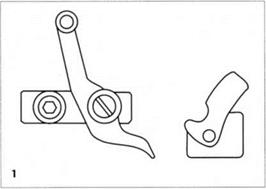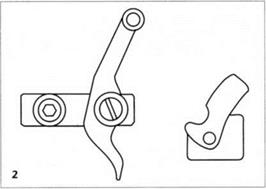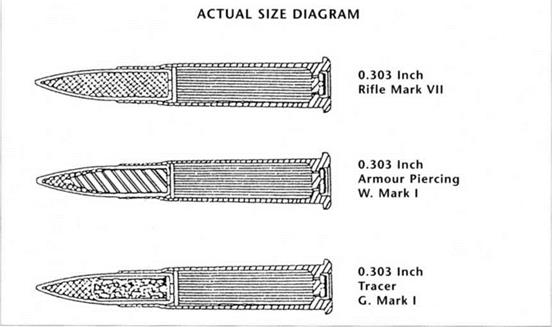APPENDIX I: MACHINE-GUN STOPPAGES AND. TYPES OF 0.303" AMMUNITION
Sir Hiram Maxim’s belt-fed machine gun was adopted by several countries, each of which made redesigns to suit circumstances and requirements. However, the basic principle remained the same.
In England, the Maxim gun developed into the Vickers water-cooled machine gun and used the same size Spitzer-type 0.303м (7.69 mm) ammunition as the Lee-Enfield infantry rifle. The bullets (projectiles) were identical.
The Maxim gun, as redesigned in Germany, used the standard German army infantry ammunition, the Spitzer-type Mauser 7.92 mm x 57 cartridge. A lightweight air-cooled version was adopted for use on aircraft and was known as the LMG 08/15, which stood for air-cooled machine gun, type 8, designed in 1915. It was manufactured, principally in the town of Spandau, just to the west of Berlin, by several companies and various different names, however, all parts were fully interchangeable. Apart from the synchronising mechanism and the barrel, the infantry and the aerial versions used identical parts in the feeding, loading and firing systems.
The German and the British machine guns, being the same basic design, responded almost identically to defective ammunition, to wear and tear and to the failure of component parts.
Cartridges were fed, loaded, locked in place, fired
and extracted somewhere between eight to ten times per second, and the lock had to withstand pressure between 45,000 and 55,000 pounds per square inch. The duty cycle of the complicated mechanism was quite heavy, and the moving parts and springs were prone to high rates of wear. In aerial use, the close- tolerance parts were subjected to the extreme cold of high altitude flying in winter; an environment for which the original design was not intended.
It was not uncommon for a fighter pilot, who had finally caught up with a high flying two-seater or airship, to have his machine guns fire just one round and then refuse to reload. The hump on the Sopwith Camel was actually a chamber which directed hot air from the engine onto the breech end of the guns to prevent that from happening.
The crank handles (or cocking handle/lever), which came in various shapes and sizes to suit aircraft types, made one backwards and forwards movement through an arc of about 110 degrees for each round fired. A jam would cause the handle to cease motion in one of four positions. The position in which the handle stopped was a reliable indicator of the basic type of jam which had occurred. Each position was known by a number, and machine-gun jams were described, for example, as ‘a number two stoppage’.
A number 1 or 4 stoppage could be cleared in the
MAXIM-TYPE MACHINE-GUN STOPPAGE POSITIONS




air. The pilot would extrac t the defective cartridge by – pulling the crank handle back to the far stop and then releasing it. The spring return would feed the next cartridge into the firing chamber.
A number 2 stoppage caused by a tight cartridge case could often be cleared in the air. A small hammer, sometimes a wooden mallet, (secured by a strap) was carried in the cockpit, and the pilot would apply it vigorously to the crank arm to force it forwards to position 4. The expression: ‘the pilot hammered his machine gun’, means exactly that; not as portrayed in the movies as beating on the breech with clenched fists.
A number 2 stoppage, caused by the previous cartridge case having separated during extraction, would have the new cartridge telescoped into the broken piece. The crank arm. when hammered, would not move. To clear such a jam was a major operation that could only be performed on the ground.
A number 3 stoppage was generally impossible to clear in the air. Both a number 2 and number 3 stoppage could be caused by the pilot himself, usually a novice who had indulged in over-long bursts of fire. This overheated the breech mechanism thus destroying the lubricant and causing the delicate parts to seize.
A component failure, frozen moisture, dirt and/or congealed lubricant could also cause any one of the four types of stoppages.
British Standard 0.303" Cartridges
With the constant improvement in rifle design, muzzle velocities began to exceed 2,000 feet per minute. The
result was that the soft round-nosed lead bullets such as the British Mark VI then used would disintegrate inside the human body causing really complicated wounds. Fragments of lead were spread over a large body area to no purpose.
The 1907 Hague Convention produced an agreement between the major European powers that lead bullets would have a pointed nose and that the lead would be fully encased in a hard metal jacket. The result is known as a Spitzer-shape (or type) bullet.
The aerodynamic Spitzer shape, when spun by a rifled barrel, was stable in flight and had excellent accuracy.
The British version, the Mark VII cartridge when fired from a 0.303′ rifled barrel, as in Lee-Enfield army rifles or in Vickers and Lewis machine guns, had a nominal muzzle velocity of 2,440 feet per second (1,664 mph) and was spun by the rifling at about 175,800 rpm. In flight the speed and rpm would gradually decrease, but even after having travelled half a mile the bullets were still supersonic. Bullets which passed close by could be heard quite clearly.
Unfortunately at ranges over 300 yards the lighter weight tracer bullet did not conform exactly to the trajectory of the rifle bullet; it lost height rapidly. Pilots who lifted the nose of their fighter to correct their aim. often achieved exactly the opposite of their intent.
In daytime, tracer ammunition could only be seen from directly behind the gun which had tired it for the trace was actually a bright pinpoint of light from inside the bullet. Stories which make reference to ‘seeing flaming tracers’are pure journalistic invention.










